Tutorial on the idiosyncrasies of the Instancing laboratory. Part 3 of 6
 pbudarick_4a3d2ac478
Posts: 0
pbudarick_4a3d2ac478
Posts: 0
For Part 1 of 6 of my tutorial, please go to [ http://www.daz3d.com/forums/discussion/3637/ ]
For Part 2 of 6 of my tutorial, please go to [ http://www.daz3d.com/forums/discussion/3924/ ]
For Rashad Carters Comprehensive Tutorial, please go to [ http://www.daz3d.com/forums/discussion/3381/ ]
I have made so many discoveries about the ARDL that it might even take more then 6 Parts of this tutorial to describe most of what i think would be relevant for Brycers, particularly when it comes to nested applications [Terrains on Terrains on Terrains on Terrains......]. The nested applications allow us to create the most immensely complex forms - such as building our own vegetation elements and Trees from scratch [particularly by using MetaBalls with the ARDL]. After having now spent months exploring the ARDL i can say with confidence that the ADRL allows us to create immensely complex objects and scenes which gives Bryce a new level of power we Brycers never had before. The last picture of this part of the tutorial [Picture_54] is a useful table. I have produced it in in Freehand 11. It shows some of the combinations of Surface and Master Objects and some of the results to be expected [based on research i have done thus far]. But before we get there we need to recap on a few things.
[039] First let us look at replication and distribution of Primitives on Primitives. Set up the Brush as shown in Picture_38 so as to make a cross [use 90 degree divergence angle to accomplish this]. While you are working through this, the ARDL will remember this Brush settup. A CSG sphere ["Primitive"] is created, enlarged and selected as the Surface Object. We will replicate and distribute various other Primitives on it. The CSG Primitives can not be made into instances since they are already instances - but of the native Bryce mathematical kind. Make a cube and send it to world centre. Then hide it under the ground plane. Make the cube quite small and elongate it so it becomes a vertical bar. That is our Master Object. Be sure to enter the Brush editor and select Cube 1 and follow all the advice of the previous parts 1 and 2 of this tutorial. Here we want random rotation selected [0 to 360 degrees]. When you paint with the brush, hold down the ALT-key which will make all the bars perpendicular to the hemisphere surface [aligned to the "normals"]. Please see Picture_39. Everything has worked as expected. The square-cross-section rods have randomly rotated. If we had used cones or cylinders we would not notice that they have rotated [please see Picture_41].
[040] Now delete the group of copies that were created [they are not instances]. Change the Master Object into a vertical slab so that the profile in the X-Z-plane is no longer square but a rectangle. Do the same as you did in [039] above. What is the result? Please have a look at Picture_40. As we learned from previous parts of this tutorial the vertical slabs are distorted. They have been rotated inside the world space bounding box. If we want them to rotate properly we have to convert the Master Object into a Mesh Object. Similar things happen with the other primitives if they have been transformed in the X-Z-plane.
[041] Now let us look at replication and distribution of primitives on Terrains [Displacement Map Objects]. Make a nice smooth conical mountain similar to Picture_42. The exact shape does not matter. You will notice that our Surface Object like the Primitives before can not be instanced. The option to convert to instance under the Edit drop down menu is greyed out when Terrains are selected. That is because a Terrain is not a Mesh Object - it is a Procedural Object [One reason you can make bigger and more highly detailed Terrains in Bryce than most other high end 3D/4D programs!] But we can put instances or copies of our Master Object on it. So we will try some pyramids. We want random scaling and random rotation set up. Picture_43 shows as the result. We get the well known rotation problem, but the scaling has randomly changed. Next we will skew our pyramid and make it quite long. Important is to use "Unrotate" after skewing at 45 degrees wich makes the base level with X-Z-plane. Now again we replicate and find that the bases of the skewed pyramids are all parallel to the sloping surface. Please study Picture_44 carefully. The pyramids have rotated inside the sloping bounding box. That is probably partly because after skewing their bases are no longer perfectly square. Finally we convert the skewed pyramid Master Object into mesh objects. Now we get them to rotate properly on the mountain slope and also we have True Instances. Please see Picture_45.
[042] Suppose we want to coat a number of overlapping Terrains with a layer of Objects. If we group the Terrains we can't enter the ARDL [This is true for all grouped Objects]. Please see Picture_46. We must then select both Terrains individually and enter the ARDL. So we paint some spheres using the same old cross-shape brush. Picture_47 shows the result. Some of our Red Balls have gone missing! To find out what has happened please have a look at Picture_48. When two Terrain surfaces overlap only one is chosen to be completely coated with copies or instances of our Master Object. What we must do is either tile two or more Terrains or make them into one Terrain. Picture_49 shows two Terrains tiled together. There is no overlap and i have made the joint obvious so you can see it. Here all the Spheres are distributed as we wanted.
[043] Then i tried an experiment. Two Terrains were joined together using BSO and then converted to a Mesh Object. This does not give good results! Please have a look at Picture_50. The Red Balls are now inside the Terrain. This happened because the normals are reversed. If you need to convert a Terrain into instances, then first export it using the Terrain Exporter as an OBJ and then import it again into Bryce [don't worry about any textures - they can be added later].
[044] Last we shall look at Mesh Objects replicated and distributed on Primitives. We can create Mesh versions of the Bryce CSG objects very easily without using any other software. I have already described this method in former parts of this turtorial. It is worth repeating that the mesh resolution [subdivision] you get in the transformed object will be that of the selected wireframe display resolution when you do the BSOp. Picture_51 shows the Torus converted and you can see i used a wireframe resolution of 16. Normally if the objects are the be very smooth you would use the highest resolution [128] but sometimes if you want a faceted effect you can choose one of the lowest resolutions. For example if you want an octagonal pyramid or an octagonal prism then you could use the lowest wireframe display resolution of 8 [for selected objects] and apply it to the cone and cylinder respectively. After import turn the smoothing off [click on the "E" button --> "Edit Mesh" --> "Unsmooth"].
[045] Now we will Replicate and Distribute our Faceted Torus on a large perfect Bryce CSG Torus. Please see Picture_52 which shows the settup in the ARDL. In this case we can have True Instances. We could have many thousands of objects embedded and Bryce handles it just fine. To get the objects embedded we have to raise the origin point in the master object by a certain amount. We can get any effect or distribution desired. I will cover some the more interesting tips in Parts 4 to 6 of this tutorial [like planting Fruits on Trees in a realistic manner]. In Picture_53 you can see one of the results. You can paint both sides by turning the Surface Object over.
[046] In other future parts of the tutorial i will describe the more interesting tips and procedures which evolved out of all this research [ more than a thousand files and 2 computers rendering 24 hours a day for over a month untill i had to rebuild my computers!]. Now we must conclude with the Table i promised. Please see Table_01. In the future as a discover more i will update it. For now there is sufficient information in it and plenty of space for more.
First of all i need to describe what it all means.
(1) On the left are two collumns for the "Surface Object Type". The "Surface Object Type" is the object on which another object [or objects - using a Mixed Brush] will be Replicated and Distributed and if possible True Instances created in the process.
In the second column the grey rectangle with the letter "I" in it has either "NO" or "YES" behind it. That means the Surface Object can itself be made into an instance or not [Please check under your Bryce Edit Menu when the object is selected - is the option greyed out?]. Similarly the Yellow rectangle with the letters "ARDL" in it indicates if the "I" button will appear at the bottom of the attributes stack of this object when selected. If it does not, then i indicate this with "NO". In most cases it appears except for groups [these require special treatment].
(2) On the right are many columns for the "Master Object Type". The "Master Object Type" is the Object which will be prepared for replication by you and then used in that process. It is best hidden somewhere but should not be deleted.
In the Matrix were Columns and Rows intersect there are white boxes with up to 6 little coloured squares in them. To make them easier to indentify some of the intersect-boxes are yellow [ indicated by (4) in the first row ]. These are the combinations which create instances automatically [If you don't turn off the "Instances" green radio button in the ARDL]. They are the ones we prefer if we are building mega scenes. At the top there is a legend to the left and right of the Heading which tells you what the little coloured squares mean. The grey squares with the letter "I" in them mean that True Instances can be created. They are found in all the yellow fields always at the top right.
The other coloured squares mean different things, you can discover for yourself.
(3) When Bryce CSG Primitives are transformed in X and Z so that they no longer have a square top profile bounding box [ relative to the ARDL which always works from the top view down the Y-axis ] then they behave in a strange way when turning randomly which we are by now familiar with. If we don't want this we must avoid those combinations. You should know that the primitives behave differently according to type. Cubes, Pyramids, Cylinders and Toruses will rotate in a distorted way. Cones and Spheres will not rotate at all. The red square with the letter "D" in it, warn about this. You should note that these Objects can be randomly scaled [as normal] which is indiceted by the green square with the letter "S" in it.
(5) Unconverted Grouped Metaballs and all Grouped objects in general will not allow entry into the ARDL. To overcome this select the individual objects that comprise the group. Aternatively select each sub object in the group and work on it in the ARDL. Then select the next one and so on. I will have more to say about this in future parts of this tutorial.
(6) Grouped Mesh Objects will neither randomly scale nor randomly rotate. They will however, like all objects, allign with normals [ Little blue squares with the letter "A" in them ].
There are many more interesting things revealed by this Table [which is not even complete]. I will go into all these in the next 3 parts of this tutorial. These parts will be more interesting because i intend to tackle specific projects. These although not too complicated will be less boring than the stuff you had to suffer from me up till now.
Kind regards
Peter
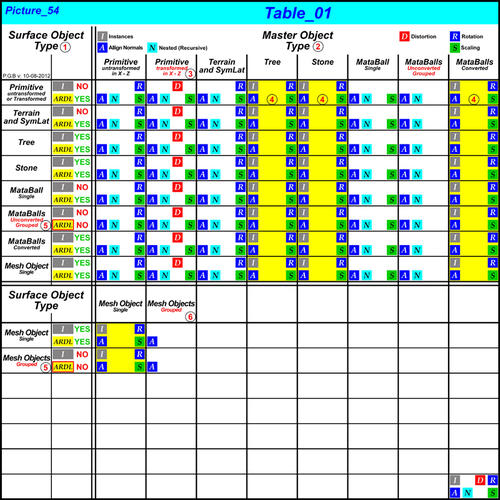

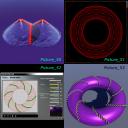

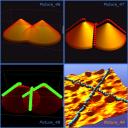

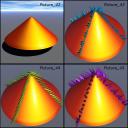

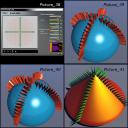



Comments
Thank you Peter for sharing your extensive research with us. I'm still finding it all a bit mind boggling... but I can see there is a lot of untapped potential here. One quick question, when I paint in the lab I tend to get five or six instances right on top of one another, even if I only give it a really light brush. Am I missing something really obvious? Is there an easy way to stop instances overlapping like this?
Thanks David,
You have no idea how much tutorial work i lost when my computer went down. But i see it as a positive because it meant i could reconfirm many things and also not be tempted to publish questionable work. If you have lost it, then you have to do it again! That also challenges your conception of things compared to when you first did it.
The rest of the tutorial will be less boring but it will take some time to get there - there is just TOO MUCH WE CAN DO WITH IT, that it is indeed mind boggling. I have lost a few nights sleep over it! I find it as mind boggling as you do David.
Yes i have had "instances on top of one other" happen to me too. I need to hold my hand very steady on the mouse and perhaps first need to have a few glasses of wine. The slightest movement and i get a stack of multiples at each location. I suppose this is not a bug, but i could be wrong [perhaps there is not a suitable time delay somewhere in the code]. Since it happened to me when i first started to use the ARDL [as well as a lot of other annoying things] i now take great care. I take a deep breath and press the mouse button very deliberately and don't move the mouse. Since then it has not happened to me anymore. Still there are times when you may want this and you can then deliberately move the mouse when you click to get it and paint thousands of instances with a very small brush of only 4 to 12 points.
Hope this helps. Thanks also for tips with curved perspective camera and 4 quadrant rendering. Will incorporate your advice into a new tutorial soon and of course will give credit to YOUR input.
B.T.W i just love your Vid Tutorials. Great stuff. Make more and more!
Kind regards
Peter
David,
I had some pictures of these clusters [as i call them] before my computer went kaput. But now they are lost!
I will see if i can reproduce this phenomena deliberately and attach a picture for you later.
Post Edit:
Yes it was easy to produce the phenomena. I used the vertical square rod with random rotation. A slight mouse jitter was introduced when clicking and carried over for a few milliseconds afterwards. Like in dynamic painting the mouse is never perfectly still for a period of time before and after the click. When i first encountered this phenomenon a couple months ago i thought it might be a useful technique for producing randomly corroded metal bars. Might be useful with the right material. I have not checked out the full range of this phenomenon since i strove to avoid it. Of course if it happens when you don't want it and you have a very large brush painting huge objects [ which are not True Instances] you may get a crash. That may explain some of the crashes people have been getting. I have recently been able to paint over 100 million polygons worth of Instances without crashes!
I suppose we could enter the mouse preferences and change the response of the mouse to suit the dynamic working methods of an artist.
The problem is that you are using too much randomness in the brush settings. Randomness needs to be very low to ensure nothing overlaps. Also, make sure you dont try to use continuous strokes when painting, you should only dab, and do dab carefully as to not accidentally drag the brush creating a momentary continous stroke.
KIne,
When you are ready I have some cool stuff to share with you and the others on memory usage. It turns out that in some cases, imported meshes make better source models than primitives in terms of memory usage. When it comes to trees, I used to think that Bryce trees were by far the most efficient manner to populate a world but I have found that imported meshes actually have an advantage.
@Kine_magiK - great! Just keep them coming.
The problem is that you are using too much randomness in the brush settings. Randomness needs to be very low to ensure nothing overlaps. Also, make sure you dont try to use continuous strokes when painting, you should only dab, and do dab carefully as to not accidentally drag the brush creating a momentary continous stroke.
KIne,
When you are ready I have some cool stuff to share with you and the others on memory usage. It turns out that in some cases, imported meshes make better source models than primitives in terms of memory usage. When it comes to trees, I used to think that Bryce trees were by far the most efficient manner to populate a world but I have found that imported meshes actually have an advantage.
Thanks Rashad,
It been some time since i "heard" form you. I love your natural work and i love to get into ecosystems. I have spent over a decade on mechanical models and i want to get out of that rut. I have no doubt that you know how to employ the ARDL with great skill [ based on your practical experience ]. I think the ARDL would be the most wonderful tool for you to take the already outstanding work you have done to another higher level.
Yes, soon when i am ready, please share with me and i will share with you too. BTW i have posted on Bryce5.com [at the forum] an apology for my rant here and also some words for you. But it looks like that forum is dead and my post did not appear. Please don't worry about it, but i just thought i should mention it. I can otherwise log into both the forum and the galleries.
Yes imported meshes [ or Bryce converted meshes ] have the advantage that with True Instances you can have millions of them [ see my table ]. I have just rendered a file with [don't get a heart attack]:..... 1trillion, 870 million, 541 thousand, 229 polygons. It takes 10 minutes or so for each edit step [so it is wise to set up your lighting and environment before you plant 5000 high res trees]. And Bryce DOES NOT CRASH. I took your advice not to click again on any action even when the Windows Task Manager "said": (program not responding). If you have patience and use the tricks you have taught us, we can have great success with mega scenes [ more about that in part 4 ]. Pictures will also come in Part 4.
Kind regards from Australia
Peter
Duplicate post removed on Horos's advice since i am incompetent at using this forum.
Probably partly my mistake. New forum members posts have to be approved by a moderator. After a few posts, the posts are auto-approved. We had to put that in place because of the spammers. I had deleted around 800 within 3 months and this had to stop. Your posts have now been approved (I've discovered them).
Probably partly my mistake. New forum members posts have to be approved by a moderator. After a few posts, the posts are auto-approved. We had to put that in place because of the spammers. I had deleted around 800 within 3 months and this had to stop. Your posts have now been approved (I've discovered them).
Danke Horo